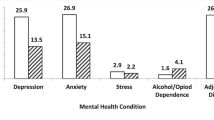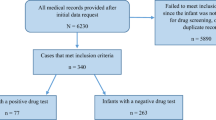Abstract
OBJECTIVE:
To analyze the relationship between perinatal drug/alcohol use and maternal, fetal, neonatal, and postneonatal mortality.
STUDY DESIGN:
Linked California discharge, birth and death certificate data from 1991–1998 were used to identify drug/alcohol-diagnosed births. Mortality relative risk (RR) ratios were calculated and logistic models were generated for mortality outcomes.
RESULTS:
Among 4,536,701 birth records, 1.20% contained drug/alcohol discharge diagnostic codes (n=54,290). The unadjusted RRs for maternal (RR=2.7), fetal (RR=1.3), neonatal (RR=2.4), and postneonatal (RR=4.3) mortality were increased for drug/alcohol-diagnosed births. After controlling for potential confounding, the odds of maternal death for cocaine use (OR=2.15) remained significant as did amphetamine (OR=1.77), cocaine (OR=1.43), polydrug (OR=2.01) and other drug/alcohol use (OR=1.79) for postneonatal mortality.
CONCLUSIONS:
The association of cocaine use with maternal mortality and any drug/alcohol use with postneonatal mortality supports screening and identifying women using illicit drugs and alcohol during pregnancy. Increased collaboration with drug treatment programs and closer follow-up for drug-using women and their children may improve mortality outcomes.
This is a preview of subscription content, access via your institution
Access options
Subscribe to this journal
Receive 12 print issues and online access
$259.00 per year
only $21.58 per issue
Buy this article
- Purchase on Springer Link
- Instant access to full article PDF
Prices may be subject to local taxes which are calculated during checkout
Similar content being viewed by others
References
Addis A, Moretti M, Syed F, Einarson T, Koren G . Fetal effects of cocaine: an updated meta-analysis. Reprod Toxicol 2001;15:341–369.
Panting-Kemp A, Nguyen T, Castro L . Substance use and polyhydramnios. Am J Obstet Gynecol 2002;187 (3):602–605.
Kelley S, Walsh J, Thompson K . Birth outcomes, health problems, and neglect with prenatal exposure to cocaine. Pediatr Nurs 1991;17 (2):130–136.
Handler A, Kistin N, Davis F, Ferre C . Cocaine use during pregnancy: perinatal outcomes. Am J Epidemiol 1991;133 (8):818–825.
Armstrong M, Lieberman L, Carpenter D, et al. Early start: an obstetric clinic-based, perinatal substance abuse intervention program. Qual Manag Health Care 2001;9 (2):6–15.
Bateman D, Ng S, Hansen C, Heagarty M . The effects of intrauterine cocaine exposure in newborns. Am J Public Health 1993;83 (2):190–193.
Kelly R, Russo J, Holt V, et al. Psychiatric and substance use disorders as risk factors for low birth weight and preterm delivery. Obstet Gynecol 2002;100 (2):297–304.
Kayani S, Walkinshaw S, Preston C . Pregnancy outcome in severe placental abruption. Br J Obstet Gynaecol 2003;110(July):679–683.
Lee T, Silver H . Etiology and epidemiology of preterm premature rupture of the membranes. Clin Perinatol 2001;28 (4):721–734.
Kilbride H, Thibeault D . Neonatal complications of preterm premature rupture of membranes: pathophysiology and management. Clin Perinatol 2001;28 (4):761–785.
Wise P, Wampler N, Barfield W . The importance of extreme prematurity and low birthweight to US neonatal mortality patterns: implications for prenatal care and women's health. JAMA 1995;50 (5):152–155.
Paneth N . The problem of low birth weight. The Future of Children 1995;5 (1):19–34.
US Department of Health and Human Services. Healthy People 2010 objectives: draft for public comment. Washington, DC: Office of Public Health and Science; 1998.
MMWR. Racial and ethnic disparities in infant mortality rates: 60 largest US cities, 1995–1998. MMWR 2002;51 (15): 329–332, 343.
Papacek E, Collings J, Schulte N, Goergen C, Drolet A . Differing postneonatal mortality rates of African-American and White infants in Chicago: an ecologic study. Matern Child Health J 2002;6 (2):99–105.
Chang J, Elam-Evans L, Berg C, et al. Pregnancy-related mortality surveillance - United States, 1991–1999. MMWR 2003;52 (SS02):1–8.
Hulse G, Milne E, English D, Holman C . Assessing the relationship between maternal opiate use and neonatal mortality. Addiction 1998;93 (7):1033–1042.
Soepatmi S, Voorn W . First week mortality and first year mortality in maternal drug dependency. Acta Paediatr 1994;83 (5):545–546.
Ostrea E, Ostrea A, Simpson P . Mortality within the first 2 years in infants exposed to cocaine, opiate, or cannabinoid during gestation. Pediatrics 1997;100 (1):79–83.
Kelleher K, Chaffin M, Hollenberg J, Fischer E . Alcohol and drug disorders among physically abusive and neglectful parents in a community-based sample. Am J Public Health 1994;84 (10):1586–1590.
Burd L, Wilson H . Fetal, infant, and child mortality in a context of alcohol use. Am J Med Genetics 2004;127C:51–58.
Danielsen B . Probabilistic Record Linkages for Generating a Comprehensive Epidemiological Research File on Maternal and Infant Health. In: 11/4/00 ed: Health Information Solutions; 2000, www.health-info-solutions.com.
Practice Management Information Corporation. International Classification of Diseases, 9th Revision, Clinical Modification. 5th ed. Los Angeles: Practice Management Information Corporation; 1997.
Burkett G, Bandstra E, Cohen J, Steele B, Palow D . Cocaine-related maternal death. Am J Obstet Gynecol 1990;163(1, part 1):40–41.
Sumits T, Bennett R, Gould J . Maternal risks for very low birth weight infant mortality. Pediatrics 1996;98 (2):236–241.
Refuerzo J, Sokol R, Blackwell S, Berry S, Janisse J, Sorokin Y . Cocaine use and preterm premature rupture of membranes: improvement in neonatal outcome. Am J Obstet Gynecol 2002;186 (6):1150–1154.
Shankaran S, Bauer C, Bada H, Lester B, Wright L, Das A . Health-care utilization among mothers and infants following cocaine exposure. J Perinatol 2003;23:361–367.
Broekhuizen F, Utrie J, VanMullen C . Drug use or inadequate prenatal care? Adverse pregnancy outcome in an urban setting. Am J Obstet Gynecol 1992;166 (6):1747–1756.
Platt R, Joseph K, Anath C, Grondines J, Abrahamowicz M, Kramer M . A proportional hazards model with time-dependent covariates and time-varying effects for analysis of fetal and infant death. Am J Epidemiol 2004;160 (3):199–206.
English P, Eskenazi B . Reinterpreting the effects of maternal smoking on infant birthweight and perinatal mortality: a multivariate approach to birthweight standardization. Int J Epidemiol 1992;21 (6):1097–1105.
Wilcox A . Birth weight and perinatal mortality: the effect of maternal smoking. Am J Epidemiol 1993;137 (10):1098–1104.
Salihu H, Aliyu M, Pierre-Louis B, Alexander G . Levels of excess infants deaths attributable to maternal smoking during pregnancy in the United States. Matern Child Health J 2003;7 (4):219–227.
Vega W, Noble A, Kolody B, Porter P, Hwang J, Bole A . Profile of Alcohol and Drug Use During Pregnancy in California, 1992. Sacramento: State of California Health and Welfare Agency; 1993.
Kogan M, Kotelchuck M, Alexander G, Johnson W . Racial disparities in reported prenatal care advice from health care providers. Am J Public Health 1994;84 (1):82–88.
Saitz R, Mulvey K, Plough A, Samet J . Physician unawareness of serious substance abuse. Am J Drug Alcohol Abuse 1997;23 (3):343–354.
Samet J, Rollnick S, Barnes H . Beyond CAGE: a brief clinical approach after detection of substance abuse. Arch Intern Med 1996;156:2287–2293.
Acknowledgements
Support was provided by Jan Morgan and Beate Danielsen from the California Office of Statewide Health Planning and Development. This study was also funded by the California Policy Research Center, the National Institute on Drug Abuse San Francisco Treatment Research Center (Center Grant P50 DA09253), and Treatment on Demand Grant (R01 DA12221).
Author information
Authors and Affiliations
Corresponding author
Rights and permissions
About this article
Cite this article
Wolfe, E., Davis, T., Guydish, J. et al. Mortality Risk Associated with Perinatal Drug and Alcohol Use in California. J Perinatol 25, 93–100 (2005). https://doi.org/10.1038/sj.jp.7211214
Published:
Issue Date:
DOI: https://doi.org/10.1038/sj.jp.7211214
This article is cited by
-
The effects of khat use during pregnancy on perinatal and maternal outcomes: a meta-analysis
Archives of Women's Mental Health (2023)
-
Prevalence and factors associated with substance use among university students in South Africa: implications for prevention
BMC Psychology (2022)
-
High Lifetime Pregnancy and Low Contraceptive Usage Among Sex Workers Who Use Drugs- An Unmet Reproductive Health Need
BMC Pregnancy and Childbirth (2011)
-
Postpartum convulsions and acute hemodynamic instability in the parturient with recent amphetamine intake
Archives of Gynecology and Obstetrics (2009)



